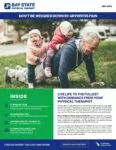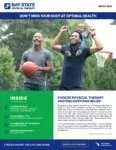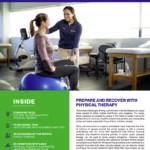The Centers for Disease Control and Prevention reports that more than 51 million people have chronic pain. The National Spine & Pain Center describes chronic pain as “pain that outlasts what is considered a normal time course for healing.” While “acute” discomfort is the body’s initial response to an injury with symptoms that decline as the body heals, chronic pain follows a vastly different pattern and lasts three months.
Chronic pain can interfere with your day-to-day work and recreational activities, and it may have a profound effect on your ability to concentrate, relax, and enjoy life. Much like that battery-powered bunny, those symptoms keep going and going and can get worse over time if not treated accordingly.
The Impact of Chronic Pain
Three common regions of the body where chronic pain is reported include:
- Back ache such as sciatica or spinal stenosis
- Headaches and migraines
- Joint discomfort such as when caused by arthritis or trauma/injury
Chronic pain affects each person differently. In some cases, it can lead to decreased activity levels, as well as anxiety, depression, and disability. Physical therapists work together with their patients to understand the origin of the discomfort, lessen their symptoms, and restore their activity to the highest possible levels. With treatment, the adverse effects of symptoms can be reduced and allow patients to return to activity-filled days ahead.
Risks of Opioids to Treat Chronic Pain
It is well known that in the United States, there has been an opioid crisis for years. Opioid dependency can affect anyone, regardless of age, gender, or socioeconomic status. Many individuals initially receive opioids as a legitimate symptoms management tool but inadvertently become trapped in the cycle of dependency.
Some reports actually reveal that although opioids do provide relief by blocking the pain signal, when the drug wears off, you will experience more pain for about three days. Over time, as you continue to take opioids, the effectiveness lessens while the symptoms continue increasing- not because the injury is worse, but because of the opioids themselves.
Movement is Medicine
When chronic pain causes a lack of movement, other physical problems are quick to follow. Inactive muscles weaken and atrophy (become smaller in size) and joints become stiff. These changes make initiating movement even more difficult. In addition, chronic discomfort can lead to increased dependence on medications such as opioids.
Your physical therapy plan of care may include:
- Education to help you understand your condition
- Manual therapy
- Postural awareness
- Body mechanics training
- Strengthening and flexibility exercises
- New forms of exercise that empower you to move with greater ease
Working together closely, your physical therapist will design a personalized care plan just for you. This will help you gain the strength, mobility, and confidence needed to reach your optimal health and activity goals. Don’t continue to suffer- break your cycle of pain with the help of Bay State Physical Therapy.
Getting started is just a click away! Call your nearest Bay State Physical Therapy location or complete the form below to request an appointment.
Tags: pain medications, PT first, Arthritis, Inflammatory Arthritis, Physical Therapy, Pain Relief, opioids







